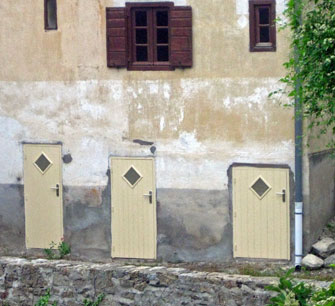
As I have discovered in my wanderings around Paris, and discussed in a previous C’est Ironique, there are a lot of things here that seem to defy explanation. And, as I discovered in a recent wander around southern France, the strangeness doesn’t stop at the city limits.
France is a country of conundrums, and I consider it my duty to get to the bottom of them. Or at least off to one side where I can get a better photo. Consider these examples…
The conundrum:
Sireul is a quaint medieval village in the Dordogne region near Sarlat, situated on a high ridge overlooking a vast, spectacular valley. It’s a small town. How small? It may have more than one horse, but it only has one public bench. And where is that bench placed? Therein lies the mystery:
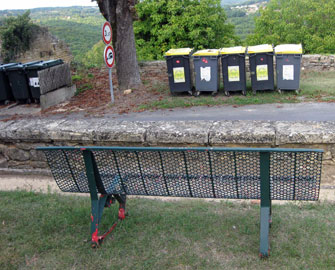
Why would any sentient being do that?
The solution:
The concept of putting the garbage bins between the bench and the view actually serves as an eloquent reminder for the citizens of Sireul. When people are sitting there, it reminds them not to litter. It reminds them to sort their trash. It reminds them to exercise more by getting up from the bench and walking (or jogging!) to the stone wall behind the dumpsters to get a glimpse of the valley. But most of all, it reminds them to vote for the opposition in the next town council elections.
The conundrum:
Here’s a phenomenon that has puzzled me for years: at every toll plaza on every French freeway, there are lanes equipped with automated credit card readers. The idea is to offer more pay lanes without having to hire more personnel. So far so good. But every single credit card lane also has a clearance barrier:
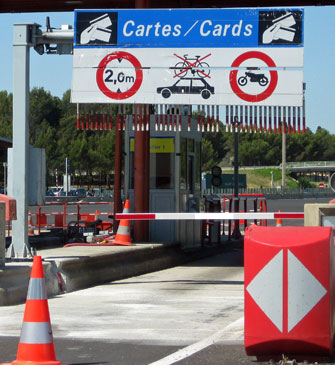
Why? Why would you be banned from going through a card-operated tollbooth just because you have bikes on your car?
The solution:
I don’t have the solution. But I had it! Right after I took this photo, while waiting long minutes in line and pondering this enigma for what must have been the hundredth time, the answer suddenly came to me. And then, just as suddenly, it left.
Today I can’t for the life of me remember what it was. It was like one of those brilliant, all-encompassing key-to-the-universe insights that people get while under the influence of cannabis and can’t recall afterward. Or, ah, so I have heard. It will probably come back to me someday, probably on another road trip. Back from Amsterdam.
The conundrum:
Speaking of stones, there are buildings all over France adorned with caryatids and telamones, those stylized human figures designed to look like they’re holding up the façade. It’s common for the sculptor to give them a look of weariness or strain to symbolize their symbolic burden. But these statues on Rue d’Alésia in Paris seem to be just plain sick:
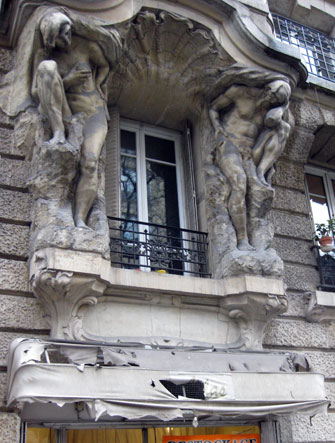
Doubled over, holding their abdomens… To be precise, they look like they just blew their baguettes, an impression heightened by the condition of the canopy right underneath. Given their job, it can’t be motion sickness. What could be making them so queasy?
The solution:
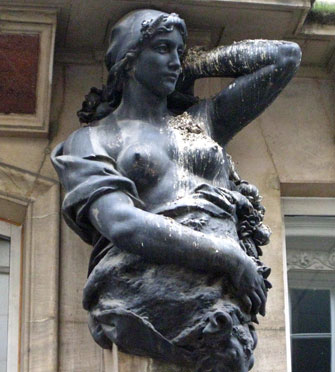
I think they’re nauseated by the plight of their girlfriend here on Rue des Petits Ecuries. She just wanted to do a little sunbathing and look what happened.
This figurine has been disfigured like this for years. Would it kill the building owners to hire someone to slap up a ladder and get rid of the guano? I know a couple of teenage boys who would probably do it for free.
The conundrum:
Isn’t it annoying when you’re lost in Paris and can’t find a street sign? It’s kind of surprising how often this happens.
But then, for the sake of symmetry, or perhaps just to be even more annoying, there are streets that have more identifiers than they need. This building across from the Bourse provides a typical example:

Notice the two different renderings of “4.” Obviously for the benefit of all those people in the world who can understand “rue,” “du” and “Septembre” but not “quatre.” And that’s nothing compared with this corner:
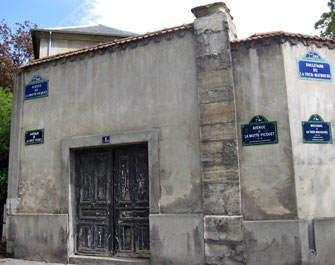
It’s hard to see in this tiny photo, but at number 1 Avenue de La Motte-Picquet, there are no fewer than three signs for the avenue on one small façade, and two for the adjoining Boulevard de la Tour-Maubourg on the next wall, all within about five meters of each other. What gives?
The solution:
In both cases, the signs are redundant but not identical. Some have just the street name, others have the street name plus that semicircular thing over it giving the arrondissement (district) number, and others have those two bits of info plus a little blurb at the bottom explaining the origin of the name.
Since this is the age of information, I suspect that the city is going to keep updating its street signs with more and more data (local history, public transport schedules, warnings not to stand under the caryatids, etc.), adding additional panels until they eventually cover the entire exterior of every building. No one will ever replaster or repaint their façades, which will slowly rot and crumble behind their layer of blue and white siding. Then all the signs will be replaced by a single flashcode and every building in town will collapse.
The conundrum:
Who should win this year’s Nobel Prize for Bad Taste?
The solution:
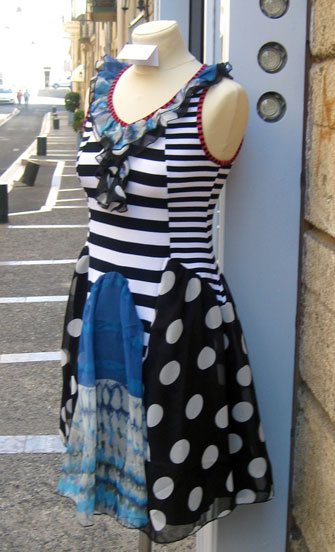
I nominate the designer of this dress proudly displayed outside a boutique in a town near Montpellier. Let’s see: six colors, three different kinds of fabric, eight different print patterns of questionable compatibility, three functionally unnecessary ruffles… I think it needs just one more thing… Hmmm… Oh — I know: a flamethrower!
The conundrum:
Why in the name of all things holy did the owner of the shop in this next photo call it that?

Spotted and photographed by gracious reader P K Munroe.
The solution:
I confess that it took me a while to figure this out, but it’s simply another example of design dysfunction. The line in the middle is not an “l,” it’s a “t” doing double duty for both words, but crossed only once (and barely at that) at the top. So we’re supposed to read it as “Instant Coton” (“The Cotton Moment” — it sounds just as lame in French). It’s a fashion boutique, not a drive-through irrigation clinic.
The conundrum:
Say you own a butcher shop, and you want to make it stand out from the competition. What can you do? Well, you could hire a designer, contract a sign maker, bring in an electrician and generally go to a lot of trouble and expense to install a customized neon beacon above your door.
Say you did all that. Wouldn’t you want to choose a form that at least looks vaguely like something—anything at all—recognizable? If you’re the owner of this butcher shop in Céret, a wonderful Catalan town in the Pyrenees, the answer is no:
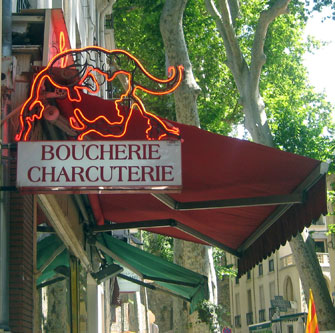
Okay, so what the bloody shell steak is that neon thing supposed to be?
The solution:
Oh wait, I see it now—it’s an instant colon!
Have you seen something inexplicable in Paris, or anywhere in France? Or an intersection with street sign overkill? Or, most importantly, can you figure out that butcher’s neon monstrosity? If the answer to any of these questions is yes, please send me a message c/o Paris Update.
Reader Rick Spring writes: “‘At every toll plaza on every French freeway’—now, there’s a conundrum!”
David Jaggard responds: “Yes, why do we have to pay for a freeway? And for that matter, why do we park on a driveway and drive on a parkway? BTW, one reader thinks that the neon sign is supposed to outline a bull, sort of like the Wall Street bull. Bull meat is the local specialty there, so this makes perfect sense, but I can’t see it—it still looks like a colon to me.”
Reader Linda Healey writes: “David, thanks for the wonderful shot of bench with the view of the garbage cans. I had U.S. friends visiting here this summer and shared with them my current theory: In France, it’s not the thing itself, it’s the concept of the thing. Hence: 1) The bench is placed in front of the view—a logical concept. 2) The yellow-topped garbage cans are placed conveniently near the other garbage cans—also a logical concept. That these two concepts must intersect and clash is—well, not a concept.”
David Jaggard responds: “Makes sense. We could call it the Healey Conundrum. I think your theory also explains the contradictory library rules I discussed in a previous column.”
© 2012 Paris Update
FavoriteAn album of David Jaggard’s comic compositions is now available for streaming on Spotify and Apple Music, for purchase (whole or track by track) on iTunes and Amazon, and on every other music downloading service in the known universe, under the title “Totally Unrelated.”
Note to readers: David Jaggard’s e-book Quorum of One: Satire 1998-2011 is available from Amazon as well as iTunes, iBookstore, Nook, Reader Store, Kobo, Copia and many other distributors.
